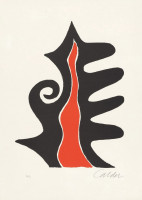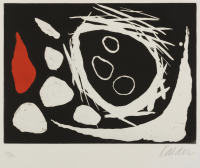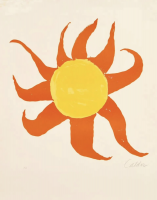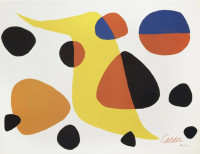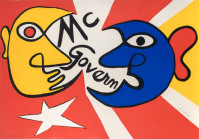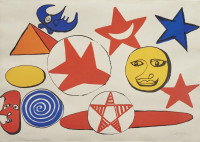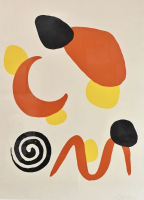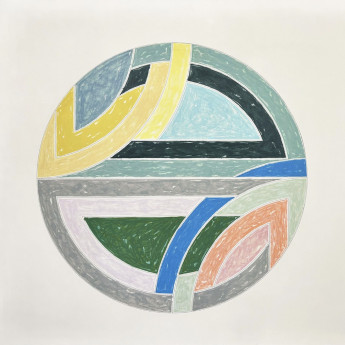
Details
Artist
Styles
Lithograph in colors on Japon nacré - Signed and numbered to lower edge - Printed by Arts-Litho, Paris and published by Éditions de la Différence, Paris. // This untitled lithograph by Alexander Calder, created in 1976 as part of the La mémoire élémentaire portfolio, presents a captivating arrangement of pyramidal shapes against a minimalist background. The pyramids, rendered in bold primary colors of red, blue, yellow, and black, rise in a geometric landscape under a stylized striped sky and a red semi-circular sun or moon. The use of flat planes and solid colors conveys Calder's signature style, which is rooted in abstraction and modernism. The simplicity of form and the precise composition invite viewers to interpret the scene freely, perhaps evoking a surreal desert or imaginative landscape. Printed by Arts-Litho and published by Éditions de la Différence, Paris, this piece is signed and numbered by Calder, exemplifying his unique approach to color, form, and spatial relationships.
Untitled (from the La memoire elementaire), 1976
form
Medium
Size
51.4 x 71.8 cm
- Inches
- Centimeters
Edition
Price
Details
Artist
Styles
Lithograph in colors on Japon nacré - Signed and numbered to lower edge - Printed by Arts-Litho, Paris and published by Éditions de la Différence, Paris. // This untitled lithograph by Alexander Calder, created in 1976 as part of the La mémoire élémentaire portfolio, presents a captivating arrangement of pyramidal shapes against a minimalist background. The pyramids, rendered in bold primary colors of red, blue, yellow, and black, rise in a geometric landscape under a stylized striped sky and a red semi-circular sun or moon. The use of flat planes and solid colors conveys Calder's signature style, which is rooted in abstraction and modernism. The simplicity of form and the precise composition invite viewers to interpret the scene freely, perhaps evoking a surreal desert or imaginative landscape. Printed by Arts-Litho and published by Éditions de la Différence, Paris, this piece is signed and numbered by Calder, exemplifying his unique approach to color, form, and spatial relationships.
- Recently Added
- Price (low-high )
- Price (high-low )
- Year (low-high )
- Year (high-low )
Alexander Calder
Le Piège (from La Memoire Elementaire), 1976
Limited Edition Print
Lithograph
USD 9,700
Alexander Calder
Hommage á Euclide / Hommage To Euclid From La Memoire Elementaire, 1976
Limited Edition Print
Lithograph
USD 9,700
Alexander Calder
Taches De Rousser (from La Memoire Elementaire), 1976
Limited Edition Print
Lithograph
USD 9,700
Alexander Calder
Untitled (Derriere Le Miroir #201), c. 1970
Limited Edition Print
Lithograph
Inquire For Price
Alexander Calder
Save Our Planet, Save Our Wildlife, 1971
Limited Edition Print
Offset Print
USD 2,850
Alexander Calder
Our Unfinished Revolution: Animals, 1976
Limited Edition Print
Lithograph
USD 9,700
Alexander Calder
Le Point De Non Retour (from La Memoire Elementaire), 1976
Limited Edition Print
Lithograph
USD 9,700
Alexander Calder
La Pointe Du Progrès (from La Memoire Elementaire), 1976
Limited Edition Print
Lithograph
USD 9,700
Alexander Calder
Our Unfinished Revolution: Octopus/Squid, 1975-1976
Limited Edition Print
Lithograph
USD 9,700
Alexander Calder
Untitled (from The La Memoire Elementaire), 1976
Limited Edition Print
Lithograph
Currently Not Available
What is abstract art?
Abstract art uses form, shape, line, and color to create a visual experience without attempting to represent external reality. The composition exists independently of the world's visual references, focusing on expressing ideas and emotions through non-representational means.











